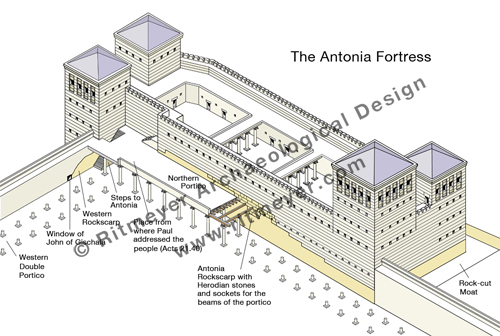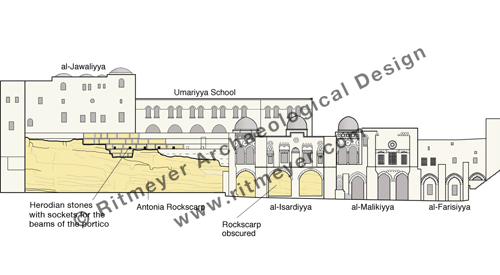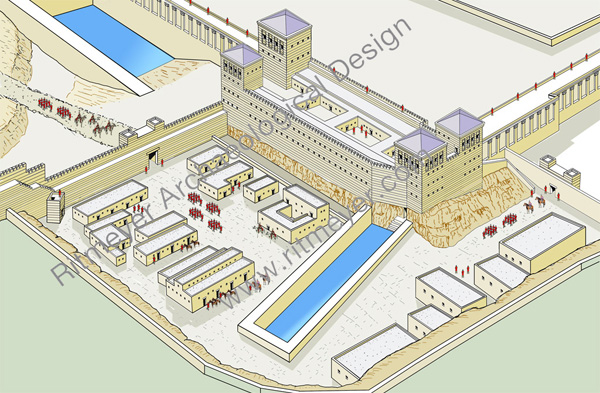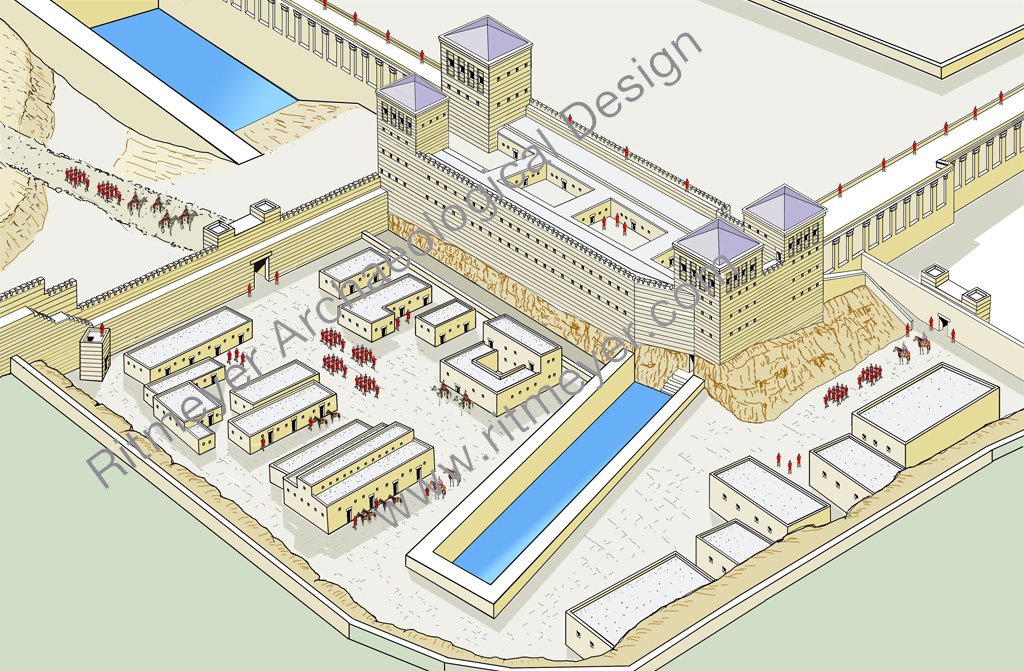One of my readers, Daniel Wright, commented on my previous blog: “Once again Leen, I would like to thank you for addressing the persistent “temple location” confusion. I frequently get questioned as to my point of view on the “City of David” location theory. Directing the inquisitive to your blog is a real asset. It is important and useful to remind readers that you worked directly for Dr. Benjamin Mazar and you were also a contemporary of Ernest L. Martin, as both of you were there in Jerusalem during the same timeframe. Your personal involvement with Mazar’s team as these things were discovered, and your role as archaeological illustrator make you a primary authority on this topic. I am grateful that you continue to publish materials that address this needless controversy.”
Thanks, for the encouragement Daniel. As promised, I now hope to deal with yet another aspect of the Temple Mount that proponents of the City of David location often bring up in support of their theory, i.e. the Antonia Fortress.
These theorisers have a problem with the existing walls of the Temple Mount and have therefore suggested that they must have belonged to the Antonia Fortress that stood north of the Temple. Such a suggestion shows ignorance of and contradicts the historical sources and archaeological evidence. Let’s begin with the historical sources.
Josephus wrote (War 5.238-246) that the Antonia Fortress was built on a rock that was 50 cubits (86 feet or 26.25m) high. The fortress had towers at its four corners. Its interior had apartments, cloisters, baths and courtyards, and looked like a palace.

Anyone who has seen a section of the Herodian Temple Mount knows that it could never be said that Temple Mount stood on such a rock. In fact, the platform swallows up Mount Moriah beneath it.
Another problem that is raised is that the accepted location of the Antonia Fortress is thought to be too restricted an area. What do the historical sources have to say about this? In War 5:244 Josephus mentioned that:
“a Roman cohort was permanently quartered there, and at the festivals took up positions in arms around the porticoes to watch the people and repress any insurrectionary movement.”
How to understand this statement? Although the rock plateau on which the fortress stood is a sizeable piece of real estate, measuring approximately 148 feet (45 m) from north to south and 394 feet (120 m) from east to west, it is indeed difficult to imagine that a cohort of about 500 soldiers and their horses could have camped inside this fortress
However, I believe that it would be a mistake to limit the boundaries of the Antonia to the rocky plateau only. The Strouthion Pool, for example, would have provided water for the Roman soldiers garrisoned here and would have been protected. At a distance of about 60m to the north is a high rock scarp that enclosed a large area where later the eastern Roman Forum was built. It is reasonable to suggest that the common soldiers camped out here in semi-permanent barracks, while the officers and commanders stayed in more luxurious and permanent accommodation on top of the Antonia rockscarp.
Another difficulty in suggesting that the Temple Mount was the Antonia, is what Josephus writes about its destruction by the Romans:
“Titus now ordered the troops that were with him to raze the foundations of Antonia and to prepare an easy ascent [into the Temple Mount] for the whole army” (War 6. 93).
“Meanwhile the rest of the Roman army, having in seven days overthrown the foundations of Antonia, had prepared a broad ascent to the Temple” (War 6.149).
Archaeology has proved this description of the destruction of the Antonia to be true, as there are no architectural remains on the rocky outcrop (apart from some cladding stones in the southern façade of the rocky plateau), that can be identified as having belonged to this fortress. The archaeological evidence agrees with the historical description of the destruction of the Antonia Fortress by the Romans.

The Temple Mount retaining walls are still standing today to a certain height and therefore could never have belonged to the Antonia. It also would have been impossible to destroy the Temple Mount down to its foundations in merely seven days.
The proposed reconstruction of the Antonia, with its adjacent area where the cohort could have been stationed, would be in harmony with the New Testament account of Paul’s arrest. In Acts 21 and 22 the Apostle is recorded as having been brought up from the Temple Mount by stairs into the “castle”, which could have been nothing other than the Antonia Fortress itself, as he was allowed to address the Jewish people that were standing below on the Temple Mount.

In Acts 21 and 22 the Apostle Paul was brought into the “barracks”, which was the Antonia Fortress itself, for he was allowed to address the Jewish people that were standing below on the Temple Mount.
In Ch. 23 we read that, in order to save Paul’s life, the tribune ordered two centurions to “Get ready two hundred soldiers, with seventy horsemen and two hundred spearmen to go as far as Caesarea at the third hour of the night.” This would have amounted to two-thirds of the cohort that was stationed in the grounds of the Antonia.
So, the historical sources and the archaeological evidence combine to show that the Antonia Fortress stood at the northwest corner of the present-day Temple Mount and that this Temple Mount is indeed the one built by King Herod the Great.


It would make sense that there were facilities and a garrison located outside the main Antonia fortress walls, as with the Herodion which as a tower measures a mere 63m in diameter in comparison, but that Josephus also describes in similar glowing terms, as seeming to be a city in its facilities. There too the vast majority of those facilities did not need to be accommodated within the main defensive structure but are included in Josephus’ description and have been excavated at the foot of the mound which today is identified as the Herodion.
Wars bk1: ch21: par10:”He also built other palaces about the roots of the hill, sufficient to receive the furniture that was put into them, with his friends also, insomuch that, on account of its containing all necessaries, the fortress might seem to be a city, but, by the bounds it had, a palace only”.
The walls of Antonia look much taller than the wall surrounding the alleged Temple Mount, therefore it makes no sense for Roman soldiers to raze the foundations of the fortress to access the Temple.
Soldiers carried provisions up the stairs to the “castle”?
Is there any archeological evidence for your latest drawing?
You are right that it would have been technically easier to breach the Western Wall, but then the Romans would have had to fight their way through densely populated areas. Anyway, I go with what Josephus wrote.
One doesn’t really want to take an attack through any narrow opening. It appears the Romans wanted to create a broad front to attack from by turning their major position of strength, namely their fortress, into a route by which they could easily bring large numbers of soldiers to bare.
But prior to this siege, the route onto the mount this way
was minimal, so taking the wall down to the rock on that elevation surely gave them the broad high ground along one side of the mount. And thus the advantage.
what is the crane and drilling machine 4?
Don’t know what you mean.
i meant on kotel plaza, see live cam
https://www.skylinewebcams.com/en/webcam/israel/jerusalem-district/jerusalem/western-wall.html
Dr. Ritmeyer, I’ve greatly appreciated your research. I’m interested in the north wall and the Antonia and wondered if you had any comment or theory about why the sockets which seem to have held up the roof of the north stoa do not continue westwards into the bedrock which seems to stand higher than the Herodian stones which are still in evidence. It seems from your illustration that the stoa would have extended westwards along this rock face.
Thanks for any insight you can give.
Duncan,
The west scarp has not been preserved as high as the southern scarp. The sockets would have been located higher than the top of the western scarp.
Sorry, I was not clear. Your diagram of the interior of the north perimeter of the Temple Mount (The Quest, p. 129) shows the rock scarp which would have formed the southern edge of the Antonia. At the western edge, this scarp is at its highest. It drops off as one moves east, and Herodian masonry begins to make up the difference in height. The sockets are in the Herodian masonry, but at a level below the highest point of the scarp. Should the sockets not continue westwards, past the point where the masonry ends? That is, shouldn’t there be some in bedrock as well? Or is there something about the shape of the scarp which explains why the sockets are no longer in evidence?
Duncan
I see what you mean. Yes, the bedrock is high enough for the placement of sockets to the west of the surviving ones, but the bedrock is so badly eroded, or damaged by the fire of the burning of the porticoes by the Romans, that they have not survived. The sockets were not very deep. The Herodian stones with the sockets are of a harder limestone than the bedrock in this location, hence its poorer preservation. I will email you a photograph of the scarp.
Hi Mr. Mr. Ritmeyer,
Your diagrams of the Antonia Fortrsss are impressive. It cleared up a lot for me about the Hoky Stairs being at the corner of the western and northern portico. These are the stairs Jesus went up to Pilate’s praetorium. The question is, where was Gabbatha exactly situated? Was it up top on the northern portico overlooking the forum or lower to the ground of the forum just below the northern portico. Anne Catherine Emmerich, a Church mystic explains in great detail the whole area of Pilate’s palace and praetorium and forum. It matches up to this research. I have been up those stairs, whi which are in Rome.
-Jack
Jack, The Apostle Paul went up these steps (Acts 21:40), but the Praetorium or Gabbatha was located inside Herod’s Palace near today’s Jaffa Gate and Citadel.
I have read that the Hasmonean Palace is another probable location for the placed where Jesus was judged, as per Bargil Pixner, OSB.
Jack, it was Herod Antipas who stayed in the Hasmonean Palace, while Pilate stayed in Herod’s Palace.
The book: PATHS OF THE MESSIAH by Bargil Pixner makes a very sound archaeological argument for the Hasmonean Palace being the site because of the longstanding veneration by Christian’s at this place where two churches were commemorating the event.
If it were Herod’s Palace, where would the Paraetorium and Gabbatha be located at it? I have seen a conjecture that it was a tribunal that would have been in between the wall and Herod’s Palace. Also, the 28 marble stairs in Rome are the steps that pilgrims ascend on their knees in piety. Where were they located. The Holy Land model of the Jerusalem portrays Herod’s Palace being very flat.
Jack, most scholars place the location where Pilate resided when in Jerusalem in Herod’s Palace, see for example: https://www.biblicalarchaeology.org/daily/biblical-sites-places/biblical-archaeology-places/herods-jerusalem-palace-trial-of-jesus/
Gabbath means a raised platform on which judicial matters were decided. It could have been anywhere in the palace.
I’ve seen about this. I’ve always known the Antonia Fortess ro. E the place. It’s been like that for long and the prisons are underneath the Daughters of Sion Convent. I k ow the pavement is dated from the 2nd century because of Hadrian, who made a pool in the area. I go by my faith and Anne Catherine Emmerich’s mystical visions, which confirm it to be the Antonia Fortress. I have conversed with Fr. Mitch Pacwa, SJ on this and he said it was the Antonia. Also Fr. Benoit, OFM of the Studoum Franciscanum excavated the area in the 1970’s in favor of the Antonia. It would make sense because the Temple was right there and the Jewish priests and scribes would have had easy access to Pilate and not enter his area for defilement. The article says it’s possible, not certain.
Expositor’s Bible Commentary on Acts 23:11, refers to Paul, “as he awaited the next turn of events in his cell at the Fortress of Antonia.” (p1052). You mention, “In Acts 21 and 22 the Apostle Paul was brought into the “barracks”, which was the Antonia Fortress itself”
Is it reasonable then to assume that Paul was indeed kept in a cell within the Fortress of Antonia for the duration of his imprisonment in Jerusalem? (Thanks for your excellent illustration of the Fortress in the ESV Study Bible, Temple Mount in the Time of Jesus). The Fortress would also be in an ideal location to maintain a careful scrutiny of the temple grounds and to come to Paul’s aid initially in Acts 21. It would therefore later be a straightforward matter to bring Paul before the Sandhedrin at the southern end of the temple area.
Our adult Bible study class has been sharing in the Book of Acts. May we use your illustrations of the Fortress of Antonia (shown on this page) in PowerPoint format to illustrate the latter portion of Acts, especially chapters 21 to 23? https://www.ritmeyer.com/2018/02/05/the-antonia-fortress/